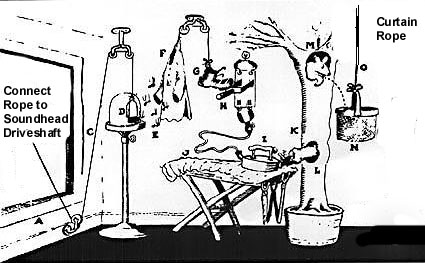|
|
This topic comprises 2 pages: 1 2
|
|
Author
|
Topic: how to motorize a curtain
|
Scott Norwood
Film God

Posts: 8146
From: Boston, MA. USA (1774.21 miles northeast of Dallas)
Registered: Jun 99
|
 posted 08-15-2002 11:53 AM
posted 08-15-2002 11:53 AM





What is the best/cheapest/easiest way to add motor control to a standard theatre curtain that was designed for manual operation?This is in a late-silent-era theatre which was evidently designed with live performances (and the union) in mind; currently, two people are required to start each show--one in the booth to run the non-sync music and film and one backstage to operate the light board and manual curtain. The light board (currently composed of Ward-Leonard resistance dimmers) should be easy to control remotely from the booth (by keeping the original board but adding an electronic dimmer inline with it), but the curtain seems to be a bit more difficult. In this case, the main traveler is also being used as masking, so there would need to be a way to set limit switches for fully closed, 1.33, 1.85, scope, and fully opened. I know that the "right" answer is probably to call someone who does theatrical rigging, but I happen to know what these companies charge, and that is not an option for what is essentially a no-budget operation. I suppose that we could add a few hundred feet of black leader to the first reel of every feature (or put in an automation system with a timer) and just have the projectionist run backstage and operate the lights and curtain, but I'd prefer the more elegant solution if possible.
| IP: Logged
|
|
|
|
|
|
|
|
Frank Angel
Film God

Posts: 5305
From: Brooklyn NY USA
Registered: Dec 1999
|
 posted 08-15-2002 03:58 PM
posted 08-15-2002 03:58 PM





And does it split from the center or does the whole thing fly? A splitting curtain is easy to motorize, a fly system is not. The fly system doesn't lend itself easily to being motorized because of the very heavy weight involved, the torque needed to start the thing moving and because the motor would have to be huge. It also would have to be setup so that it doesn't just stop when the curtain/track assembly gets to the top of the grid -- it needs some very sophisticated control circuitry to make it slow down. If it has reached full speed hauling this rig up to the grid and doesn't slow down, the whole thing will slam against the grid and possibly rip it out of its moorings. To make a fly curtain work costs big bucks.We started out with a manual fly curtain and the best we could in terms of control was to run a cable backstage from the booth with a simple 12v indication OPEN (green) and CLOSE (red). The projectionist flips the switch and the motor (a stagehand with his hands on the ropes) pulls one way or the other. At first we used the existing headset system so the two could talk to one another, but that proved to cumbersome, both for the curtain puller -- to easy to get the headset cable caught up in the ropes, and same for the projectionist. So we went to the indicator box. BUT we found a simple open/close was not good enough. You need to have additional feedback indication, another light and switch that the stagehand can send indication to the projectionist that he actually is standing there by the curtain, so you don't wind up with the situation where the projectionist starts the show because he is on time, but the only thing down by the curtain rope is this stupid light flashing OPEN OPEN. If you have a split curtain, usually you will find it is on one of a few standard ADC theatrical tracks. A motor can be rigged quite easily to these tracks but you may need to re-rope it with a special rope made specifically being run by a motor pulley. It is made of rope material but in its center there is aircraft cable. You need this to avoid the stretching that happens with plain rope cable -- the motor, unlike the human pulling the rope cannot compensate if the rope has stretched or shrunk. The motor just stops where the mechanical/relay stops are set; if the rope has stretched due to humidity, it won't close all the way or open all the way. The aircraft cable does away with that problem. As for multiple stop points, most of the old motors have an intermediate stop setting but not enough for all your ARs. You may need to rig small magnetic reed switches at the various points and a magnet on the curtain first carrier that will trip the switches. We tried this but found that is was much easier to just have the projectionist watch the curtain and stop it manually where he wants it. What we eventually did to get around the fly curtain was to mount two ADC Specifine tracks on the screen frame itself and used very lightweight satin curtain material both for the mask and curtain. Using lightweight material instead of the traditional 24lb velour was necessary so as not to over stress the frame and it allowed us to use fairly small motors -- one for the mask and one for the curtain. The
mask motor must be driven by a chain so that it will stop exactly where needed. The main curtain used the special aircraft core cable. We got both motors used for about $200 each. I devised a cheating system once that allowed this theatre to have side masking that couldn't be done with the standard type of mask setup, plus, it didn't require a separate motor nor the full expanse of mask material. This was critical in this theatre because the off-stage area was never designed for a full double width of curtain to be installed. There was barely enough off-stage space to hold the main curtain; there was no additional space for the full width of side masks. The solution was to install a mask track right behind the curtain track. Two pieces of black lightweight velour, the same as would normally be used as side masking, were hung on the track, but instead of them being the full width of the screen from the 1.37 AR position, these were only three feet in width. The carriers of these pieces were forced to stay separated by a length of aluminum at the track, connecting the two carriers and also on the bottom keeping the velour from fold together as it was pulled opened. This masking was then just simply attached to the leading carrier of the main curtain with a foot & 1/2 length of small chain. As the curtain opened, it simply dragged the side mask pieces along behind it. The main curtain stopped at the proper distance from the picture, leaving the black mask to stop exactly where it needed to frame the picture. When the curtain was closed, it moved in toward the center, passing the mask pieces and closing completely. To the audience, it looked like any other mask setup only they couldn't see that behind the main curtain, the side masking was no more than a few feet in width. This setup allowed the screen to have a black surround, yet it didn't require the additional space that a standard mask would have required -- space that this particular proscenium simply didn't have to spare. This worked flawlessly for a few years before the theatre closed. Keep us posted on your progress. And send PICTURES.
| IP: Logged
|
|
|
|
|
|
|
|
John Schulien
Expert Film Handler

Posts: 206
From: Chicago, IL, USA
Registered: Nov 1999
|
 posted 08-15-2002 10:16 PM
posted 08-15-2002 10:16 PM




A rather funky way to do it would be find a straight shot from the curtain mechanism to the booth, possibly through the ceiling, and thread together some steel pipes to make a long driveshaft. Drill through the pipe connecting joints and insert cotter pins to keep the driveshaft segments from unscrewing, and put a hand crank in the booth. Then you could open the curtain by hand from the booth!Alternately, you could use something along these lines:  You'll need a fairly heavy squirrel for this to work. Good luck!
| IP: Logged
|
|
Phil Hill
I love my cootie bug

Posts: 7595
From: Hollywood, CA USA
Registered: Mar 2000
|
 posted 08-15-2002 10:29 PM
posted 08-15-2002 10:29 PM



Most (modern) curtain motor-drives have several "stops" that are controlled by a "shaft-rotation counter" that is part of the motor assembly. They are easily set and controlled from the booth via a mult-position switch for different formats. Last time I was at Dick Niccums' a few weeks ago, there were several on the used shelf.
http://www.lightingimages.com/used-reconditioned.htm >>> Phil
| IP: Logged
|
|
|
|
Scott Norwood
Film God

Posts: 8146
From: Boston, MA. USA (1774.21 miles northeast of Dallas)
Registered: Jun 99
|
 posted 08-16-2002 09:23 AM
posted 08-16-2002 09:23 AM





No, there aren't any control wires (at least none that are marked) from the booth to the backstage area, but we could run them through the mezzanine (which isn't normally used as a seating area) or attic, at least temporarily. We'll probably be re-running speaker wires, anyway. There is no way to run a rod or other manual control mechanism from the stage to the booth; this is an old-style theatre with procenium, etc. The current booth is on the main floor, just behind the last row of seats.John -- let me know what you find. I really want to make this curtain and the house lights remote-controllable ASAP, since it looks so great when illuminated with the footlights. Here's an article on the theatre; they're switching formats from "adult" movies (on videotape) to full-time art-house films: http://www.projo.com/movies/content/projo_20020816_columbus.586d2.html (And if there's anyone in Providence who knows anything about film or sound or theatre organs or is an electrician and who has some spare time to volunteer, either let me know or stop by sometime. Most of us who are helping with this at the moment live an hour's drive away....)
| IP: Logged
|
|
|
|
William Hooper
Phenomenal Film Handler
Posts: 1879
From: Mobile, AL USA
Registered: Jun 99
|
 posted 08-17-2002 09:49 AM
posted 08-17-2002 09:49 AM





I side with Gordon & Frank both, & come from a different angle.
I think this needs to be done with an overall system design.If you're doing this with an older house, it will at some point do PAC duty, & as such experience & observation have proved that it's essential that the movie part of the theater must not only fulfill 1. The technical requirements for showing movies but two more: 2. It must be self-contained: easy to operate, ideally by just one person (the projectionist); it has to get completely out of the way when not in use so as not to attract the hostility of the stage folks; it at best should not incorporate other components of the stage which could be made unavailable or problematic (like legs or the house grand for masking, the house grand just because a stagehand may be needed to operate it well or poorly; & its self-containment would preclude the stage folks from robbing bits off it if needed "in a pinch" for one of their emergencies. 3. It's got to look good from an auditorium decoration standpoint: I really began to understand that this is a functionality issue, because if somebody doesn't like it's looks, it's gone; & even more important is the fact that looks is what these places are selling - in most towns there are theaters with better stage facilities, or more up-to-date film installations, you're selling the looks of the auditorium & if folks don't like that, you've got nothing to sell & nobody will buy it. So for keeping it self-contained, I think it's essential that it all go on the screen frame & all begone when it flies out or they put something in front of it. What Frank described is EXACTLY what I was going to do at another house. As you take care of your masking issue on the frame, you also take care of your grand curtain issue. Even in current installs with house-colored masking, the black edge is rarely more than around 12" or 18", & best when it's just enough to get the boards in for the knife edge. Also the system as described by Frank means that if you ever have to go from a wider opening to a narrower one, the "grand" must close entirely first. AND another plus is that it's a light system, & even instead of using light scrim material (which likely wouldn't be best, because it does pass light which would make a ghost picture beneath, I'd recommend using light, metallic, lame' - type material. It was typical for screen drapes in the 70s, etc., & you don't get a penalty of not having light absorption as with the heavy velour drapes when you hit the screen with the picture at the top of the show - because it works the *opposite* way: it scatters light like a laser light show as the grand opens. It has even less "read" than velour. Hang that on your screen frame, take it all out, movies are self-contained & zero problem at all times. Even though it's a light system, Gordon is right that it needs to be by the book. That stuff has weight, & many of the screen frames installed after silents went out likely won't support additional soft goods (although many did have masking installed on them.) That needs to be checked & considered. On the other hand, if it's a house from the silent days, I think you'll find that it's hung from more damn steel than anything else onstage & that the blocks & mounts for the screen would probably support flying the damn Titanic. Silent era screens were fixed in aspect ratio, & instead of having uninteresting masking at the sides had fairly ornate scenery pieces into which the screens were set & the whole heavy mess flown out altogether. So think of it as a system. You need masking. Mount it on the screen. Make the system include the grand. All problems fixed. Leave the house grand open, or if the masking doesn't go all the way out, in a little bit to add another layer of drapes at the front of the house. As for #3, the appearance issue, it's not hard. The worst that you can do are those houses with an ornate proscenium &/or valance curtain, & when a movie is shown it's just a black hole of legs & borders surrounding a white screen. It may be functionally OK for a screen, but for the theater it's a liability. It's ugly, & people comment on how ugly it looks. You've got to have as little black edge for masking as possible, & the rest ornate, colored, gone-to-hell frou-frou. Just Use Metallic Gold. All that drapes stuff at the front of the house has to be layers, & in different shapes, different colors, different shades of the same color, & etc., but there's always gold. And even if there's a gold velour curtain up there already somewhere, metallic gold is a different, working shade. If they use a curtain warmer, BANG it goes to work. If they don't use a curtain warmer, it's still the neccessary visual change needed there. Flat black & metallic gold. You'll solve almost all problems in these houses with one or the other, just know which one is supposed to go where, & you figure that out by looking at the application & seeing how it's supposed to work. Management changes & tech crews change at these houses. New management may realize a utilitarian front end is a liabilitly, say it's ugly & pitch it out, even if the old management didn't care about a utilitarian front end. Even if the old tech crews were great, professional guys, some day new ones who are apes may come in & screw with stuff. Functionality, simplicity, operability, & bulletproofing are essential for every design. The damn thing has got to do what you want it to do.
| IP: Logged
|
|
Frank Angel
Film God

Posts: 5305
From: Brooklyn NY USA
Registered: Dec 1999
|
 posted 08-17-2002 04:11 PM
posted 08-17-2002 04:11 PM





Scott, We got our motor rope from Mutual Hardware in Queens NY, but I don't see a website for them. There is a phone number: 718-361-2480. I am sure this stuff is very common and should be available from any theatrical supply house, or they can probably ship it directly to you. As for an easy way to re-rope the track, there's no such thing. The smartest way, is to remove the curtain itself so that working on the track isn't impeded by the physical bulk of the curtain material. We had access to a Genie hydrolic arm and work cage that was a major help. I can't imagine the exponental difficulty level that would be reached if you had to do it with ladders. Although I never re-roped other than with dropping the curtain off the track, I am told it is possible to do this without taking the curtain down. I've never see it done. It is also possible to use the existing rope to pull the new rope through the track. I assume that because of your theatre's age, you will be working with the one of the larger traveler tracks commonly used in those theatre's rigs. Pulling new with can be done with the larger, heavy duty tracks where there is plenty of space between the carriers and the top of the track itself. You could attach the old rope to the new taking care to make a joint that is not bulky and will clear the carriers. Unfortunately, the small Specifine track that we use simply didn't have the space necessary to do that and we had to pull out the old rope and then thread the new rope over the carriers. I can tell you that it is not an easy task, but if it's got to be done, you just hunker down and do it. William's post was great -- lots of good points, especially how the system has to be self-contained and "stage-hand friendly." He is absolutley right -- if they see it as a hassle, running movies will become something they will resent. And you have to anticipate how it will play with any crew, now or in the future and any projectionist --his controls have to be straight forward and right there on his console, not somewhere on the wall that is not immediately self-explanitory. You always want a new guy who has never come into the booth before be able to just look at the layout and know how to run a perfect show without the veteran guy needing to spend three days showing him the booth quirks. But back to the stage guys -- you want them to be able to drop the screen, anchor it, setup the motors and then walk away. I have my mask and curtain motors both mounted on the same rolling dolley. They roll the whole unit, both motors, into place together -- the unit is wired so that a single AC cable plugs into the wall and a single control cable with a multi-plug connector screws into its mate on a wall box. You want to wire it up so that they need to connect as few wires as possible. I even wire in a feedback loop that shows indication on the projectionist pannel that the motor rig is actually plugged into AC (you would be surprised how many times they can forget that) and the control cable is plugged. I still have to figure out a way to show that the ropes are correctly wrapped around the pulleys, but have yet to come up with an answer. As William points out, a "movie" curtain separate and distinct from the grand rag adds so much more to the presentation. I wish I had thought about the gold metalic -- I used cream white satin, but wound up with it not being absolutely opaque -- most people don;t even notice, but I can see an ever so slight darkening where the mask is. Nobody else sees it, but they are not madmen. You have to design for the most insane guy in the house. The metalic material probably is even lighter than the satin. But both are light catchers. When the curtain warmers hit the satin, it just comes alive -- shimmering and throwing all sorts of highlights off it, as I am sure so does the gold metalic. I have two scoop washes, one gel-ed with deep amber, the other with light yellow; they sit on both corners of the stage focused at steep angles across the curtain -- they cast contrasting deep shadows and highlights and the damn thing just looks spectacular. You look at it and realize that anyone who is satisfied with letting their patrons walk into the theatre to see a naked screen surround by a depressing black void needs to be in the undertaking business. Frank
Frank
| IP: Logged
|
|
|
|
All times are Central (GMT -6:00)
|
This topic comprises 2 pages: 1 2
|
Powered by Infopop Corporation
UBB.classicTM
6.3.1.2
The Film-Tech Forums are designed for various members related to the cinema industry to express their opinions, viewpoints and testimonials on various products, services and events based upon speculation, personal knowledge and factual information through use, therefore all views represented here allow no liability upon the publishers of this web site and the owners of said views assume no liability for any ill will resulting from these postings. The posts made here are for educational as well as entertainment purposes and as such anyone viewing this portion of the website must accept these views as statements of the author of that opinion
and agrees to release the authors from any and all liability.
|

 Home
Home
 Products
Products
 Store
Store
 Forum
Forum
 Warehouse
Warehouse
 Contact Us
Contact Us




 Printer-friendly view of this topic
Printer-friendly view of this topic


















